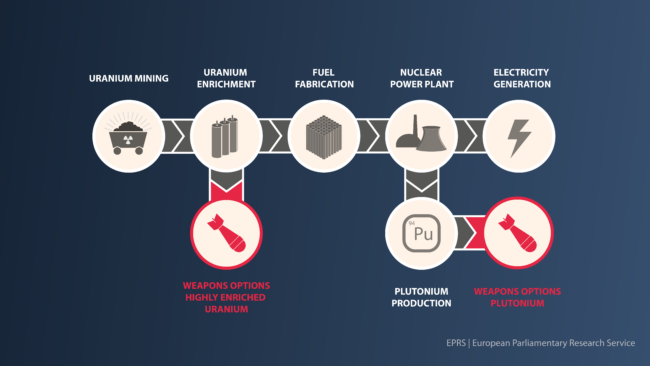by Shannon James

This map shows uranium deposits and Tribal reservations in the Western U.S. Map via Stanford.
Over the past year, the federal government has doubled-down on nuclear energy, initiating policies meant to fast-track “advanced” reactor deployment and prop up the domestic nuclear industry. Supporters call it a “nuclear renaissance,” but let’s be clear: this is not a beacon of progress. It’s a high-risk, high-cost gamble that threatens public health, safety, environmental justice, and a clean energy future.
Nuclear energy has always been riddled with false promises. These projects can take decades — if they’re ever completed at all — and typically come in far over budget. When reactors do come online, it is ratepayers who foot the bill through soaring electricity costs. Meanwhile, uranium extraction continues to devastate Indigenous lands, and the industry still has no viable long-term solution for the radioactive waste it creates. So why are we barreling down this dangerous path, when we have safer, faster, and far cheaper energy sources like wind, solar, geothermal, and storage?
In the past year alone, the federal government has plowed ahead with a reckless pro-nuclear agenda that fast-tracks approval of a new type of nuclear technology, bypasses historic safety measures, and decreases public and regulatory oversight. In July 2024, the Accelerating Deployment of Versatile, Advanced Nuclear for Clean Energy (ADVANCE) Act was signed into law, requiring the Nuclear Regulatory Commission (NRC) to “streamline its licensing process,” i.e. weakening its safety reviews. Alarmingly, the law even directs the NRC to revise its mission statement to prioritize efficiency and industry support over its foundational responsibility: protecting public health and safety.
On the campaign trail, Pres. Donald Trump acknowledged the risks of nuclear energy, citing its complexity, ballooning costs, and safety concerns. Yet since returning to office, he’s reversed course. In May, he signed four executive orders aimed at quadrupling U.S. nuclear capacity by 2050, adding 300 gigawatts of new capacity, and dismantling the NRC’s independence in the process. These executive orders:
- Mandate expedited approvals for new reactor designs and licenses, limiting the NRC’s ability to conduct thorough safety reviews.
- Shrink the NRC by reducing staff and reevaluating critical radiation safety standards.
- Transfer greater authority to the Department of Energy (DOE) and Department of Defense (DOD), bypassing independent oversight. This includes directing DOE to approve three new reactor designs by July 2026.
- Prioritize nuclear expansion as a tool for “national security” and powering energy-intensive industries like artificial intelligence data centers.
The common theme? Accelerate nuclear development at the expense of public safety, environmental review, and regulatory integrity. The consequences of this reckless agenda are already showing. Around the same time the executive orders were signed, the Department of the Interior approved a uranium mine in Utah after just 11 days of environmental review — a process that normally takes years due to the serious risks of uranium contamination. What could possibly go wrong?

This image via European Parliament Research Services illustrates the connection between nuclear energy and nuclear weapons.
The only new nuclear plant to come online in the U.S. in the past 30 years is Georgia’s Vogtle plant, completed at a staggering cost of $36.8 billion. Despite the hype, not a single small modular reactor (SMR) is operating in the U.S., and just three exist globally (one in Russia and two in China). The notion that DOE will approve three entirely new reactor designs by next year and build 300 gigawatts of nuclear capacity over the next 25 years is nothing short of a dangerous pipe dream.
In June, Pres. Trump abruptly fired NRC Commissioner Chris Hanson, a move that raised alarms. The Union of Concerned Scientists called it a threat to the agency’s independence and its ability to ensure nuclear safety. Then in July, it came to light that a staffer from the Department of Government Efficiency (DOGE) who was assigned to the NRC told top officials in May that the NRC would be expected to “rubber stamp” reactors approved by DOE or DOD. This effectively sidelines the NRC’s ability to independently assess the safety of new reactor designs. These moves, taken together, represent the most aggressive political interference in the NRC since its founding. They threaten to transform what should be a watchdog agency into a lapdog, paving the way for risky, untested nuclear technologies to be rushed onto the grid with minimal oversight.
Then, at the end of July, another commissioner at the NRC, Annie Caputo, announced her resignation as the Trump Administration escalates efforts to streamline nuclear energy rules and reduce the agency’s independence. Caputo, known for her industry-friendly stance, cited a desire to focus on family, but her departure raises concerns about deeper political shifts at the NRC.
This isn’t just a bureaucratic battle; it’s about public health, safety, environmental justice, and our future. Nuclear energy is not necessary to meet our climate goals. Clean, affordable, and proven technologies like wind, solar, geothermal, and storage are already here. What we need is the political will to invest in them, not to pour billions into a failed industry with a harmful track record. MEIC will continue to push back against this expensive and dangerous nuclear agenda and NorthWestern Energy’s continued interest in building a new nuclear plant to enrich its shareholders, and we’ll be counting on your voice to help.
This article was published in the September 2025 issue of Down To Earth.

